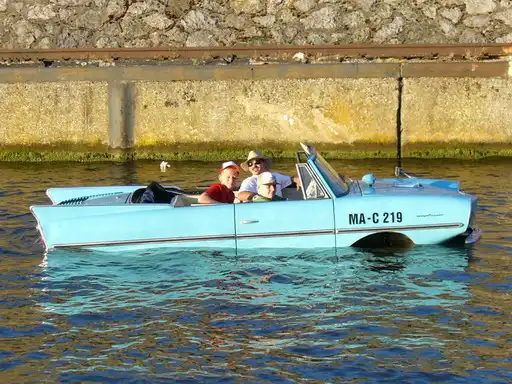In the early 1960s, amid rising fascination with bold automotive innovation, the Amphicar 770 made its debut: a quirky, dual‑mode convertible engineered to operate both as a road‑going vehicle and a watercraft. Marketed as the “fastest car on water and fastest boat on land,” this unusual design promised versatility and fun—with modest performance and enduring charm. More than six decades later, it remains a cultural icon of ambitious engineering.
Origins and Development
The Amphicar 770 was unveiled at the 1961 New York Auto Show, conceived by German engineer Hans Trippel, whose earlier amphibious work included military designs. Manufactured in West Germany by the Quandt Group at Lübeck and Berlin-Borsigwalde, nearly 3,878 units were produced between 1960 and 1965, though sales and registrations extended into 1968 in some markets.
The name “Amphicar” cleverly blends “amphibious” with “car,” while the model number “770” signified its dual top speeds: 7 mph on water and 70 mph on land.
In designing a civilian-use amphibious vehicle, Trippel secured government support, positioning the Amphicar as a daring export opportunity—though its modest specs and high cost (roughly double that of a Volkswagen Beetle) limited mass appeal.
Design, Performance, and Technical Details
The Amphicar’s rear-mounted Triumph Herald engine displaced 1,147 cc and output around 38–43 bhp. It powered the rear wheels on land via a 4-speed manual gearbox, and—upon engaging a separate lever—the twin nylon propellers for water propulsion.
On land, it spanned approximately 14.25 ft (4.34 m) in length, weighed around 2,315 lbs (1,050 kg), and could cruise close to 70 mph (110 km/h).In water, top speed peaked at 7 knots (about 8 mph)—hence the “7‑70” model name. Steering remained the realm of the front wheels, even in water—an innovation that traded nautical agility for mechanical simplicity.
To maintain hull integrity and performance, owners had to grease 13 points after water use; one of these maintenance points required removing the rear seat to access it. Doors featured double‑seal mechanisms, activated via interior levers, to ensure better watertight integrity.
Despite its novelty, some reviewers lamented its lack of polish: Time magazine disparaged it as “a vehicle that promised to revolutionize drowning,” citing leakage reliance on the bilge pump. Others acknowledged its charm, noting that when properly maintained, an Amphicar could remain afloat for days without failing.
Cultural Impact and Notable Moments
Though not without flaws, the Amphicar captured public imagination and featured in various roles:
- U.S. President Lyndon B. Johnson, known for his sense of humor, owned one—famously goingad driving guests into a lake, bellowing “brakes failed,” all in jest.
- In 1967, four Amphicars joined the Alaska–Yukon Centennial Flotilla, navigating the Yukon River over 460 miles from Whitehorse to Dawson City.
- In 1962, two Amphicars crossed the English Channel, reaching Calais, albeit one required towing.
They also appeared in films and television—ranging from Inspector Clouseau and The President’s Analyst to The Simpsons—further cementing their place in popular culture.
Legacy and Preservation
Although production ended in 1965, many examples survive and still participate in “swim‑ins”—owner gatherings where Amphicars drive straight into lakes. In Disney Springs (Orlando), enhanced Amphicars offer public water rides, upgraded for safety and reliability.
Today, among civilian amphibious cars, the Amphicar remains unmatched in production volume—nearly 4,000 produced, far exceeding any other such vehicle to date.
Its legacy inspired modern designs: WaterCar, for instance, built the high-performance Panther (80 mph land, 45 mph water) and set speed records—but none captured quite the charm of the original amphibious convertible.
The Amphicar 770 stands as a testament to bold, unconventional engineering—a convertible that could plunge into lakes and cruise highways. While its performance was modest and maintenance demanding, it offered unmatched novelty and continues to spark affection among collectors, historians, and the curious public alike.
In blending land and water mobility with playful design, the Amphicar remains a vintage oddity that was ahead of its time—and still swimming in our cultural memory.
